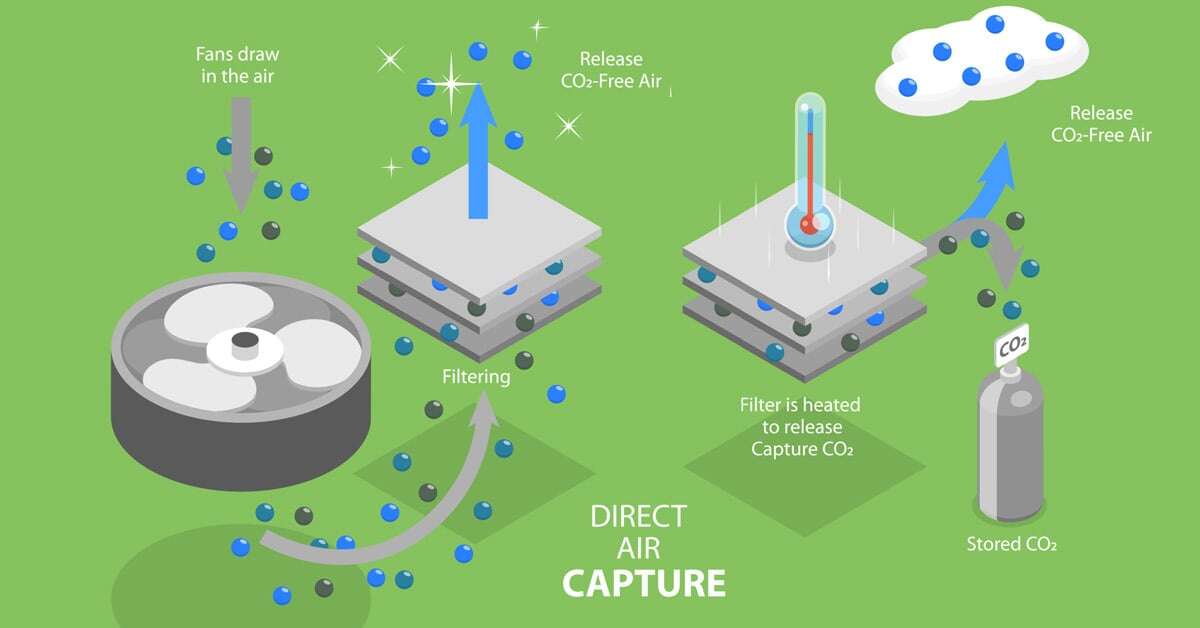4 min read
DAC Technology Sees $80 Million Investment in US-Based CarbonCapture
ResourceWise
:
Mar 13, 2024 12:00:00 AM

In the battle against global warming, Los Angeles-based startup CarbonCapture is making significant strides. Their goal? To manufacture machines that actively remove carbon dioxide from the atmosphere.
The technology is called direct air capture, or DAC.
The company recently announced an influx of $80 million in investment funding for continued development. This funding marks a significant capital injection into the DAC sector.
A host of influential organizations led the Series A fundraising, including Prime Movers Lab, Saudi Aramco, Amazon's Climate Pledge Fund, Siemens Financial Services, Idealab X, and Marc Benioff's TIME Ventures. Together, they're backing CarbonCapture's innovative approach to climate change mitigation.
How CarbonCapture Innovates in the DAC Field
CarbonCapture's unique modular machines are designed to absorb carbon dioxide when cooled, and then release it when heated. This allows for effective carbon capture, with the warming gas then safely stored underground or repurposed into products like concrete.
The magic of its DAC platform is the use of modular concepts in sync with open business strategies. CarbonCapture’s sorbent technology can be deployed across a range of applications, making it an attractive solution for many businesses.
The company's modular open systems yield an effective blend of advanced technical design and the openness of commercial deployment and scalability. These individual components align together, 'nesting' or 'stacking' in layers known as tiers.
The tier system enables innovation at an individual level without the need for modifications in the rest of the structure. Each tier layer can be updated or customized independently. This way, any advancements or improvements won't necessitate a rip-and-replace scenario, as changes can happen within a level without impacting the tiers above or below.
CarbonCapture’s modular open systems architecture is all about ensuring incremental upgrades—a vital aspect that speeds up innovation while keeping it cost-effective. By offering flexibility and scalability, the company hopes for long-standing options for various carbon capturing requirements.
DAC: A Carbon Mitigation Solution in High Emissions Industries?
As the effects of climate change grow increasingly severe, governments and investors are turning to DAC removal as one part of the overall solution. This technology is often presented as a pathway to carbon neutrality for sectors that are particularly challenging to decarbonize.
Fossil-fuel intensive material production, like cement, can potentially benefit from this option. Technology has not caught up to producing these materials without intensive carbon output. In the interim, a mitigating intervention like DAC can serve as a reality-based compromise.
Fossil fuel corporations such as Saudi Aramco, Occidental Petroleum, and UAE rival ADNOC are backing carbon removal initiatives like CarbonCapture’s. The extraction of carbon dioxide offers these oil companies some options in their operations. Furthermore, their past experiences of injecting carbon dioxide underground to aid in crude oil extraction present them with valuable expertise to bring to the table.
Related: BlackRock Invests Massive $550 Million to Occidental DAC Carbon Plant
Unlike some companies in the DAC sector, CarbonCapture embraces a variety of partnerships, including those with oil companies. CarbonCapture's belief is that a collective effort is crucial to overcome the formidable challenge of climate change, and that small, isolated tech firms in the industry alone are insufficient.
Is DAC a ‘Band-Aid Solution’ to Carbon Emissions?
Despite this optimistic outlook, DAC has faced strong pushback in the low-carbon sector. Some critics claim that the technology provides a ‘band-aid solution’ for petroleum and other high-emissions companies. They can simply carry on with their immense carbon output operations, install a DAC system, and claim they are adopting a carbon reduction plan.
The problem with this arrangement is scale. For instance, one of CarbonCapture’s initiatives, Project Bison in Wyoming, aims to capture about 5 million metric tons of carbon dioxide a year by 2030. An ambitious goal, no doubt, but this only reflects a drop in the pond of the 6 billion metric tons of yearly carbon emissions in the US alone.
Related: Removing Carbon Dioxide from the Air: Direct Air Capture
The reality of DAC in its current form is that the overall high cost and relatively low yield of CO2 capture is outpaced by the clamoring demands of decarbonization. This is where most of the objections to this technology rest. Critics say the money spent investing in DAC could be better used in technology that reduces carbon emissions more efficiently and at a lower cost.
Making Changes Today for a Better Tomorrow
The answer to these criticisms rests somewhere within the tension between established industries and the emerging low-carbon sector.
High-intensity carbon emitters, like petroleum companies, must seek out some methods to decarbonize their operations. Current and emerging regulations, public outcry, and the existential threat of climate change have all made this demand loud and clear.
But the true costs of complete infrastructure upheaval make any sort of radical change impossible. Additionally, there are some industries that simply have no current technology to successfully adapt and make the broad decarbonization changes seen in other industries.
The idealist critique of DAC says that investors should hold their money for something better as we anticipate some newer, better carbon capture or decarbonization solutions down the road. But the truth is that DAC solutions are here right now, ready to deploy. We can at least mitigate some of the effects of carbon emissions which would otherwise make their way into the atmosphere and worsen the problem.
Weighing the scales between some or none, it becomes evident why DAC continues to gain traction and investment attention.
Anyone paying attention to the carbon transition awaits the latest technology to improve our ability to capture CO2. In the meantime, DAC companies like CarbonCapture are producing real results that many companies say are well worth the investment money. As their investments grow, they will also find better ways to innovate and improve their overall results.
Invest in Your Decarbonization Planning with Prima CarbonZero from ResourceWise
ResourceWise offers a range of commodity intelligence solutions to keep your business informed about what’s important. Our low-carbon fuels and feedstocks platform, Prima CarbonZero, provides award-winning data and analytics centered on helping your business manage risk while finding a reality-grounded route to decarbonization.
Learn more about Prima CarbonZero to see all the ways ResourceWise can take your business into a net-zero carbon future.




